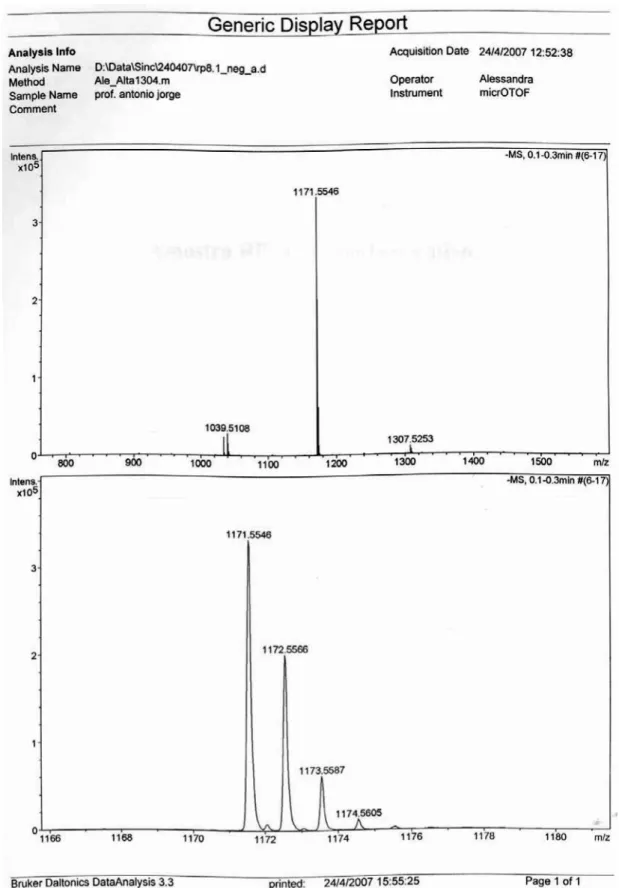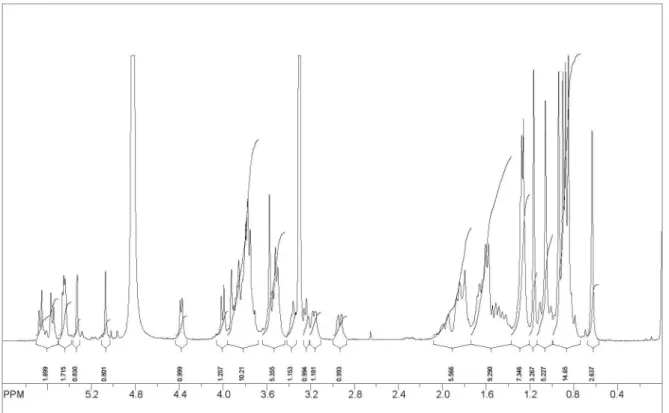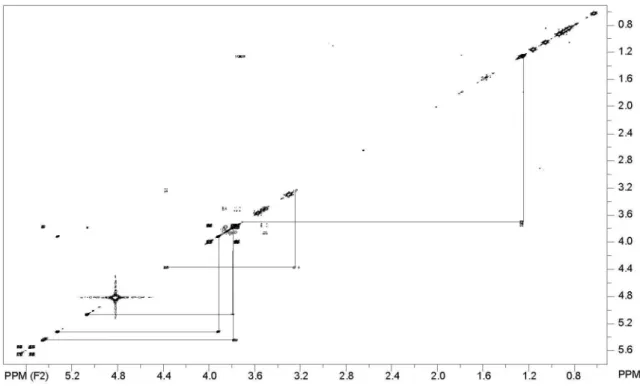Article
J. Braz. Chem. Soc., Vol. 20, No. 9, 1738-1741, 2009. Printed in Brazil - ©2009 Sociedade Brasileira de Química 0103 - 5053 $6.00+0.00
*e-mail: rmborges@nppn.ufrj.br
Two New Oleanane Saponins from
Chiococca alba
(L.) Hitch.
Ricardo M. Borges,*,a Luzineide W. Tinoco,a José D. de Souza Filho,b Nancy dos Santos Barbic and Antonio Jorge R. da Silvaa
aNúcleo de Pesquisas de Produtos Naturais and cFaculdade de Farmácia, Centro de Ciências da Saúde,
Universidade Federal do Rio de Janeiro, 21941-590 Rio de Janeiro-RJ, Brazil
bDepartamento de Química, Instituto de Ciências Exatas, Universidade Federal de Minas Gerais,
31270-901 Belo Horizonte-MG, Brazil
Duas saponinas triterpênicas foram isoladas do extrato etanólico das raízes de Chiococca alba (L.) Hitch. (Rubiaceae). Suas estruturas foram elucidadas por RMN de 1H e 13C 1D e 2D
e por espectrometria de massas de alta resolução com ionização por eletronebulização como 3-O-β-D-glucopiranurosil-3-β-hidroxiolean-12,15-dien-28-oato de O-α-D-apiofuranosil (1→3)- [α-D-apiofuranosil (1→4)]-α-L-rhamnopiranosil (1→2)-α-L-arabinopiranosila (1) e 3-O-β -D-glucopiranurosil-3-β-hidroxiolean-12,15-dien-28-oato de 28-O-α-D-apiofuranosil (1→3)-α -L-rhamnopiranosil (1→2)-α-L-arabinopiranosila (2).
Two triterpene saponins were isolated from the ethanolic extract of the roots of Chiococca alba (L.) Hitch (Rubiaceae). Their structures were determined by 1H and 13C 1D and 2D NMR and
high resolution electrospray mass spectrometry as 3-O-β-D-glucopyranurosyl-3β -hydroxyolean-12,15-dien-28-oic acid 28-O-α-D-apiofuranosyl (1→3)-[α-D-apiofuranosyl (1→4)]-α -L-rhamnopyranosyl (1→2)-α-L-arabinopyranosyl ester (1) and 3-O-β-D-glucopyranurosyl-3β -hydroxyolean-12,15-dien-28-oic acid 28-O-α-D-apiofuranosyl (1→3)-α-L-rhamnopyranosyl (1→2)-α-L-arabinopyranosyl ester (2).
Keywords: Chiococca alba, cainca, Rubiaceae, triterpene saponins
Introduction
Chiococca alba (L.) Hitch. (Rubiaceae), commonly known as “cainca” in Brazil, is a tropical and sub-tropical shrub spread all over the American continent. Its root bark is used in Brazilian traditional medicine for the treatment of several illnesses.1 Toxicological studies demonstrated absence of mutagenic activity in the ethanolic extract of the roots of C. alba and also low acute and sub acute toxicity by the oral route. Nevertheless, toxicity by parenteral routes was indeed pronounced.2
Previous works on C. alba reported the occurrence of lignans, coumarins, ketoalcohols,3 triterpenes,4 iridoids,5 flavonoids,6 two quinoline alkaloids7 and a nor-seco -pimarane.8
The present paper reports for the irst time the isolation and structure elucidation of two triterpenoidal saponins from the ethanolic extract of the roots of C. alba.
Experimental
General experimental procedures
Optical rotations were measured on a Perkin Elmer model 243B polarimeter. Infrared spectra were recorded on a Nicolet Magna spectrometer. 1H NMR and 13C NMR spectra were recorded at 200 and 50 MHz (Varian Gemini 200), at 400 and 100 MHz (Bruker DRX 400) and at 600 and 150 MHz (Bruker DRX 600) in methanol-d4 and chloroform-d
1with TMS as internal standard.
Borges et al. 1739 Vol. 20, No. 9, 2009
GC/MS instrument (5% phenylmethyl silicone column, 30 m × 0.25 mm ID, 0.25 μm ilm thickness; programmed column temperature from 110 to 290 oC, 5 oC min-1).
Plant material
Samples of C. alba were collected in Nova Friburgo, Rio de Janeiro, Brazil. The botanical identiication was provided by Dr. Sebastião Neto, and a voucher specimen (RB395399) is deposited in the Herbarium of Rio de Janeiro Botanical Garden.
Extraction and isolation
Air-dried and powdered roots of C. alba (400 g) were extracted with ethanol. The extract was evaporated; the residue obtained (12 g) was suspended in water and successively partitioned with methylene chloride and butanol. The butanol fractions were combined, evaporated and the residue (4 g) was suspended in methanol and subjected to controlled precipitation with diethyl ether. The precipitate (2 g) was fractionated by column chromatography (octadecylsilane, 60 × 20 cm) using H2O with increasing proportions of methanol (0% to 100%) to afford 10 fractions. TLC tests carried out with Liebermann-Bouchard and sulfuric orcinol reagents together with the observation the abundant foam formation, allowed the identiication of the saponin enriched fractions. Further puriication was carried out with reversed phase (octadecylsilane) preparative HPLC using methanol: 0.02% aqueous triluoroacetic acid (60:40; v/v) to afford chiococcasaponin I (78 mg) and chiococcasaponin II (48 mg).
Chiococcasaponin I (1)
Amorphous white solid, UV transparent, [α]D25 = −58 (MeOH; c 1). IR (KBr) vmax/cm-1: 3428, 2944, 1732, 1040, 986. 1H NMR (methanol-d
4, 400 MHz) and
13C NMR
(methanol-d4, 100 MHz) (Table 1). HRES/ESI/TOF MS (negative mode) calculated for C57H88O25, [M-H]−:
m/z 1171.5536; found: 1171.5546. HRES/ESI/TOF MS (positive mode), calculated for C57H88O25Na, [M+Na]+: m/z 1195.5512; found: 1195.5513.
Chiococcasaponin II (2)
Amorphous white solid, UV transparent, [α]D25 = −46 (MeOH; c 1). IR (KBr) vmax/cm-1: 3426, 2946, 1736, 1137, 1077, 1053, 1034, 980. 1H NMR (methanol-d
4, 400 MHz) and 13C NMR (methanol-d
4, 100MHz) (Table 1). HRES/ ESI/TOF MS (negative mode) calculated for C52H80O21, [M-H]−: m/z 1039.5114; found: 1039.5122. HRES/ESI/TOF
MS (positive mode), calculated for C52H80O21Na, [M+Na]+: m/z 1063.5089 found:1063.5084.
Acid hydrolysis
A solution of each saponin (5 mg per 2 mL of 0.5 mol L-1 aqueous TFA) was poured in a Kontes heavy wall pressure resistant vessel and heated for 2 min in a microwave oven at full power. The reaction mixture was cooled, diluted with water and extracted with diethyl ether. The organic layer was concentrated under vacuum and the residue was methylated with diazomethane. 3β-hydroxyolean-12, 15-dien-28-oate methyl ester was identiied by MS and NMR as the aglycone for both saponins.
MS (EI, 70eV) m/z 468 (2%); 260 (42%); 245 (14%); 231; 207; 201 (100%); 187 (14%); 173; 157; 145; 131 (46%); 119; 105; 95; 81; 69; 55. 13C NMR (chloroform-d
1, 100 MHz): 16.125); 17.0 23); 18.3 26); 19.6 (C-6); 23.6 (C-30); 24.4 (C-11); 25.1 (C-27); 27.1 (C-2); 28.5 (C-24); 31.3 (C-20); 33.8 (C-22); 33.9 (C-29); 33.9 (C-17); 34.1 7); 35.7 21); 38.2 10); 39.8 1); 40.3 (C-4); 41.3 (C-8); 43.5 (C-18); 44.6 (C-19); 45.6 (C-1(C-4); 48.7 (C-9); 57.2 (C-5); 91.2 (C-3); 124.7 (C-12); 128.6 (C-15); 137.8 (C-16); 141.5 (C-13); 176.1 (C-28).
The aqueous phase was lyophilized, the monosaccharides were reduced with sodium borohydride in water and the
O HO HO OH HOOC O O OH HO O O O O OH Me O O HO OH O HO HO OH O HO O HO HO OH HOOC O O OH HO O O O O OH Me O HO OH O HO HO
Two New Oleanane Saponins from Chiococca alba (L.) Hitch. J. Braz. Chem. Soc. 1740
resulting alditols were acetylated (acetic anhydride/ pyridine, 1 h). The alditol acetates of arabinose, rhamnose and apiose were identiied by direct comparison with authentic samples using GC/MS. The monosaccharides were also characterized by TLC on silica gel (butanol/acetic acid/water, 2:1:1). The spots on TLC plates were visualized by spraying with sulphuric-orcinol solution followed by heating. Glucuronic acid, arabinose and rhamnose were identiied by comparison with authentic samples.
Results and Discussion
The HRES/ESI MS (positive mode) of chiococcasaponin I (1) exhibited a pseudomolecular ion peak [M+Na]+ at m/z 1195.5513 and the negative mode HRES/ESI-MS exhibited a pseudomolecular ion peak [M-H]− at m/z 1171.5546,
both peaks being consistent with the molecular formula C57H88O25. Acid hydrolysis of 1 afforded the aglycone and the following monosaccharides: glucuronic acid, rhamnose, arabinose and apiose which were identiied by GC/MS and TLC analysis. Due to the fact that apiose is a branched-chain sugar, incomplete acetylation is often observed for it when standard alditol acetylation conditions are utilized. This leads to the observation of two peaks for the partially acetylated apiose alditols in the GC/ MS analyses. This behavior has already been described by Harris.9 The aglycone had its structure conirmed as 3β-hydroxyolean-12, 15-dien-28-oic acid by comparison of its 1H and 13C NMR spectra with literature data.4 This is the irst report on the occurrence of a 15,16 unsaturated oleanolic acid saponin. 1H and 13C NMR data are shown in Table 1. 1D 1H and 13C NMR, DEPT and HSQC spectra conirmed the presence of ive sugar residues corresponding to anomeric protons/carbons at 4.38/107.0, 5.12/101.4, 5.39/94.4, 5.19/112.5 and 5.29/112.2 ppm respectively. The anomeric proton at 4.38 ppm (d, J 7.3 Hz) displayed an array of correlations with signals at 3.24, 3.37, 3.51 and 3.76 ppm in the TOCSY spectrum. These 1H chemical shifts and the respective correlated carbons (HSQC) at: 75.3, 77.7, 73.3, 75.4 ppm together with the carboxyl group appearing at 176.0 ppm are consistent with the presence of a
β-glucopyranurosyl residue. A further correlation, observed in the HMBC spectrum between the proton at 4.38 and the carbon at 91.1 ppm (C-3) conirmed the location of the
β-glucopyranurosyl residue at C-3. Another correlation, between protons at 4.38 and 3.17 (aglycone H-3), observed in the T-ROESY spectrum reinforced the above deduction. The conigurations at the anomeric carbons were assigned with the help of a NMR J-resolved heteronuclear experiment, on the basis of the measured 1J
C,H: 164 Hz for the signal at 94.4 ppm (C-1, Ara), 170.6 Hz for the signal
Table 1. Carbon and proton NMR data for Chiococcasaponins I and II (100 and 400 MHz, CD3OD, internal TMS
Chiococcasaponin I Chiococcasaponin II
Carbon 1H 13C 1H 13C
1 CH2 1.60 / 1.01 39.7 1.60 / 1.01 39.8
2 CH2 1.87 / 1.7 27.1 1.85 / 1.68 27.1
3 CHOH 3.17 (dd, J 11.1 / 3.5 Hz)
91.1 3.17 (dd, J 11.1 / 3.5 Hz)
91.2
4 C -- 40.2 -- 40.3
5 CH 0.82 57.0 0.82 57.2
6 CH2 1.45 19.4 1.60 19.6
7 CH2 1.68 / 1.54 33.8 1.60 / 1.50 34.1
8 C -- 41.2 -- 41.3
9 CH 1.66 48.7 1.65 48.7
10 C -- 38.2 -- 38.2
11 CH2 1.97 / 1.86 24.3 1.95 / 1.84 24.4
12 CH 5.44 124.6 5.46 124.7
13 C -- 141.6 -- 141.5
14 C -- 45.5 -- 45.6
15 CH 5.54 128.7 5.54 128.6
16 CH 5.67 137.5 5.66 137.8
17 C -- 33.6 -- 33.9
18 CH 3.92 (dd, J 13.1 / 2.78 Hz)
43.4 2.93 (dd, J 13.1 / 2.78 Hz)
43.5
19 CH2 1.58 / 1.10 44.6 1.56 / 1.09 44.6
20 C -- 31.3 -- 31.3
21 CH2 1.26 35.6 1.26 35.7
22 CH2 1.81 33.6 1.80 33.8
23 CH3 0.86 (s) 16.9 0.85 (s) 17.0
24 CH3 1.06 (s) 28.4 1.06 (s) 28.5
25 CH3 0.88 (s) 16.0 0.88 (s) 16.1
26 CH3 0.64 (s) 18.3 0.63 (s) 18.3
27 CH3 1.17 (s) 25.0 1.16 (s) 25.1
28 C=O -- 176.1 -- 176.1
29 CH3 0.90 (s) 33.6 0.90 (s) 33.9
30 CH3 0.93 (s) 23.5 0.93 (s) 23.6
Ara at C-28
1 CH 5.39 (d, J 4.4 Hz) 94.4 5.46 (d, J 5.4 Hz) 94.4
2 CH 3.80 75.4 3.78 75.4
3 CH 3.51 72.5 3.76 72.5
4 CH 3.81 68.1 3.82 67.4
5 CH2 3.56/3.86 64.9 5.51/3.88 64.0
Rha
1 CH 5.12 (s) 101.4 5.06 (s) 101.7
2 CH 3.95 72.3 3.79 72.7
3 CH 3.76 80.8 3.86 71.7
4 CH 3.62 79.2 3.52 80.2
5 CH 3.83 69.0 3.75 69.2
6 CH3 1.27 (d, J 6 Hz) 18.5 1.28 (d, J 6 Hz) 18.5 Api
1 CH 5.19
(d, J= 1.7 Hz)
112.5 5.33
(d, J= 1.7 Hz) 111.6
2 CH 4.04 79.3 3.92 78.6
3 C -- 80.7 -- 80.6
4 CH2 3.76/4.05 74.9 3.76/4.00 75.0
5 CH2 3.59 65.3 3.58 65.5
Api
1 CH 5.29 (d, J 1.7 Hz) 112.2 --
--2 CH 3.95 78.3 --
--3 C -- 80.4 --
--4 CH2 3.77/4.05 75.1 --
--5 CH2 3.56 65.5 --
--GlcUA at C-3
1 CH 4.38 (d, J 7.3 Hz) 107.0 4.38 (d, J 7.3 Hz) 107.0
2 CH 3.24 75.3 3.24 75.5
3 CH 3.37 77.7 3.37 77.9
4 CH 3.51 73.3 3.51 73.4
5 CH 3.76 75.4 3.79 75.4
Borges et al. 1741 Vol. 20, No. 9, 2009
at 101.4 ppm (C-1, Rha), 157 Hz for the signal at 107.0 ppm (C-1, GlcUA), 169.8 Hz for the signal at 112.2 ppm (C-1, Api) and 169.8 Hz for the signal at 112.5 ppm (C-1, Api).10, 11
The individual spin systems for the other monosaccharide residues were assigned with the aid of the correlations between the anomeric protons (or methyl signal, for rhamnose) and the remaining protons in 2D TOCSY and COSY spectra. The chemical shifts of the apiofuranosyl residues were identified on the basis of C-3 being quaternary carbons (80.7, 80.4 ppm) and C-4 and C-5 being two methylenes. The assignments were double checked by comparison with literature chemical shift data and from HSQC and HMBC correlations. The sequence of the oligosaccharide chain was determined by a combination of DEPT, HSQC, HMQC, HMBC and T-ROESY experiments. Thus, the correlation observed in the HMBC spectrum between signals at 5.12 (H-1 rhamnose) and 75.4 ppm (C-2 arabinose) indicated the linkage of the rhamnose residue to the position 2 of the arabinose residue. A correlation between signals at 5.12 (H-1 rhamnose) and 3.80 (H-2 arabinose) in the T-ROESY spectrum conirm this glycosidic linkage. The connection of the two terminal apiofuranose residues to positions 3 and 4 of the rhamnose unit was conirmed by the following HMBC correlations: 3.62 ppm (H-4 rhamnose) to 112.2 ppm (C -1, apiofuranose); 3.76 ppm (H-3 rhamnose) to 112.5 (C-1, apiofuranose). Finally, the HMBC correlation between the proton at 5.39 (H-1, arabinose) and C-28 conirms the location of the tetrasaccharide. Thus, Chiococcasaponin I (1) is a typical GOTCAB (glucuronide oleanane triterpenic type carboxylic acid 3,28-O-bisdesmoside) according to the classiication of Tan et al.11
The HR-ESI-MS (positive mode) of chiococcasaponin II (2) exhibited a pseudomolecular ion peak [M+Na]+ at m/z 1063.5084 and in the negative mode exhibited a pseudomolecular ion peak [M-H]− at m/z 1039.5122,
both peaks being consistent with the molecular formula C52H80O21. Acid hydrolysis of 2 afforded the aglycone 3β-hydroxyolean-12, 15-dien-28-oic acid and the following monosaccharides: glucuronic acid, rhamnose, arabinose and apiose which were identiied by GC/MS and TLC analysis. The hydrolysis reaction suggested the presence of the same sugar residues and aglycon as in 1. However, a comparison of the 13C NMR, HSQC, HMBC and MS data indicated a difference between the sugar chain structures 1 and 2. Thus, the lack of ive signals in the 13C NMR
spectrum and the anomeric signal at 5.29 ppm in the 1H NMR of 2 together with the 132 mass units of difference
between Chiococcasaponin I (1)and Chiococcasaponin II (2)clearly indicates the absence of an apiofuranosyl residue in 2. It is worth of mention the upield shift (ca. –7 ppm) observed for C-3 in the rhamnose residue of 2 denoting absence of substitution at this site.
Acknowledgments
R.M. Borges acknowledges CNPq for the fellowship. The authors acknowledge Centro Nacional de Ressonância Magnética Nuclear de Macromoleculas Jiri Jonas, IBqM/ UFRJ for 400 and 600 MHz NMR spectra.
Supplementary Information
Supplementary data are available free of charge at http://jbcs.sbq.org.br, as PDF ile.
References
1. Mors, W. B.; Rizzini, C. T.; Pereira, N. A.; Medicinal Plants of Brazil, Reference Publications Inc.: Algonac Michigan, 2000.
2. Gazda, V. E.; Gomes-Carneiro, M. R.; Barbi, N. S.; Paumgartten, F. J. R.; J. Ethnopharmacol.2006, 105, 187.
3. Abd El-Haiz, M. A.; Weniger, B.; Quiron, J. C.; Anton, R.; Phytochemistry1991, 30, 2029.
4. Bhattacharyya, J.; Cunha, E. V. L.; Phytochemistry1992, 31, 2546.
5. Carbonezi, C. A.; Martins, D.; Young, M. C. M.; Lopes, M. N.; Furlan, M.; Rodrigues-Filho, E.; Bolzani, V. S.; Phytochemistry 1999, 51, 781.
6. Lopes, M. N.; de Oliveira, A. C.; Young, M. C. M.; Bolzani, V. S.; J. Braz. Chem. Soc.2004, 15, 468.
7. El-Abbadi, N.; Weniger, B.; Lobstein, A.; Quirion, J. C.; Anton, R.; Planta Med.1989, 55, 603.
8. Borges-Argáez, R.; Medina Baizabal, L.; May Pat, F.; Waterman, P. G.; Pena-Rodriguez, L. M.; J. Nat. Prod.2001, 64, 228.
9. Harris, P. J.; Carbohydr. Res.1992, 227, 365.
10. Agrawal, P. K.; Pathak, A. K.; Phytochem. Anal.1996, 7, 113. 11. Tan, N.; Zhou, J.; Zhao, S.; Phytochemistry1999, 52, 153.
Received: October 14, 2008
Supplementary Information
J. Braz. Chem. Soc., Vol. 20, No. 9, S1-S12, 2009. Printed in Brazil - ©2009 Sociedade Brasileira de Química 0103 - 5053 $6.00+0.00
*e-mail: rmborges@nppn.ufrj.br
Two New Oleanane Saponins from
Chiococca alba
(L.) Hitch.
Ricardo M. Borges,*,a Luzineide W. Tinoco,a José D. de Souza Filho,b Nancy dos Santos Barbic and Antonio Jorge R. da Silvaa
aNúcleo de Pesquisas de Produtos Naturais and cFaculdade de Farmácia, Centro de Ciências da
Saúde, Universidade Federal do Rio de Janeiro, 21941-590 Rio de Janeiro-RJ, Brazil
bDepartamento de Química, Instituto de Ciências Exatas, Universidade Federal de Minas Gerais
31270-901 Belo Horizonte-MG, Brazil
Two New Oleanane Saponins from Chiococca alba (L.) Hitch. J. Braz. Chem. Soc.
S2
Figure S2.1H NMR of chiococcasaponin I.
Borges et al. S3 Vol. 20, No. 9, 2009
Figure S4. COSY of chiococcasaponin I.
Two New Oleanane Saponins from Chiococca alba (L.) Hitch. J. Braz. Chem. Soc.
S4
Figure S6. HMBC of chiococcasaponin I.
Borges et al. S5 Vol. 20, No. 9, 2009
Two New Oleanane Saponins from Chiococca alba (L.) Hitch. J. Braz. Chem. Soc.
S6
Borges et al. S7 Vol. 20, No. 9, 2009
Two New Oleanane Saponins from Chiococca alba (L.) Hitch. J. Braz. Chem. Soc.
S8
Figure S11.1H NMR of chiococcasaponin II.
Borges et al. S9 Vol. 20, No. 9, 2009
Figure S13. COSY of chiococcasaponin II.
Two New Oleanane Saponins from Chiococca alba (L.) Hitch. J. Braz. Chem. Soc.
S10
Borges et al. S11 Vol. 20, No. 9, 2009
Two New Oleanane Saponins from Chiococca alba (L.) Hitch. J. Braz. Chem. Soc.
S12









